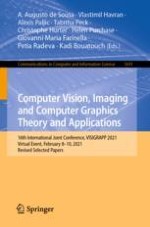This book constitutes the refereed proceedings of the 16th International Joint Conference on Computer Vision, Imaging and Computer Graphics Theory and Applications, VISIGRAPP 2021, held as a virtual event, February 8–10, 2021.
The 16 full papers presented in this volume were carefully reviewed and selected from 371 submissions. The purpose of VISIGRAPP is to bring together researchers and practitioners interested in both theoretical advances and applications of computer vision, computer graphics and information visualization. VISIGRAPP is composed of four co-located conferences, each specialized in at least one of the aforementioned main knowledge areas, namely GRAPP, IVAPP, HUCAPP and VISAPP.
The contributions were organized in topical sections as follows: Computer Graphics Theory and Applications; Human Computer Interaction Theory and Applications; Information Visualization Theory and Applications; Computer Vision Theory and Applications.
